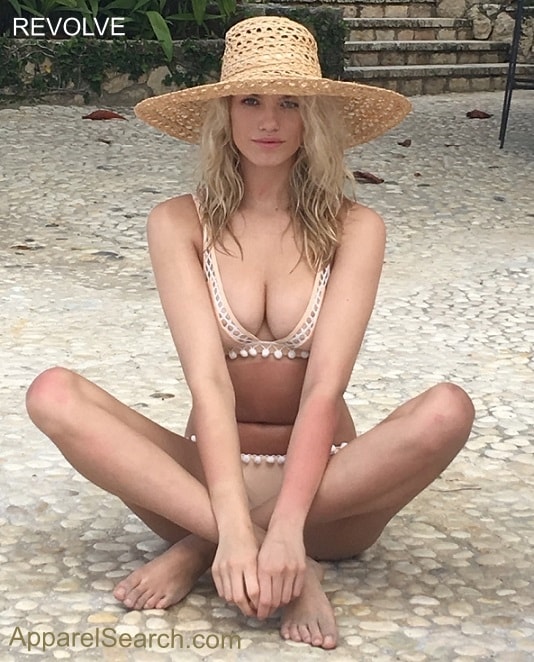
Sun Hats

Climate change is a hot topic to say the least. If the sun is melting the polar ice caps, what is it doing to the skin on our faces?

A hat is a head covering which is worn for various reasons, including protection against the elements, ceremonial reasons, religious reasons, safety, or as a fashion accessory. Another great use for a hat is sun protection. A sun hat can be both stylish and protective. The primary purpose of a sun hat is to shade the face and shoulders from the sun.
A sun hat (also known as the harvest hat or field hat) is a head covering specifically designed to shade the face and shoulders from the sun. The sun hat incorporates a variety of materials and types, including the straw sun hat, pressed fiber sun hat, and the pith helmet (sun helmet). In modern times, sun hats are common in places around the world, mainly in holiday resorts residing in countries close to the Earth's equator. They are particularly useful in protecting against ultraviolet rays (UV). The style of a sun hat can range from small to large brims. However, as a general guideline, the brim is four to seven inches in length. The larger the brim, the more shade can be provided.
A straw hat is a brimmed hat that is woven out of straw or straw like materials from different plants or synthetics. The hat is designed to protect the head from the sun and against heatstroke, but straw hats are also used in fashion as a decorative element or a uniform. There are several styles of straw hats, but all of them are woven using some form of plant fibre. Many of these hats are formed in a similar way to felt hats; they are softened by steam or by submersion in hot water, and then formed by hand or over a hat block. Finer and more expensive straw hats have a tighter and more consistent weave. Since it takes much more time to weave a larger hat than a smaller one, larger hats are more expensive. Straw hats have been worn in Europe and Asia since after the Middle Ages during the summer months, and have changed little between the medieval times and today.
Straw hats are commonly blocked into shapes found in felt hats.
Boater hat — a formal straw hat with a flat top and brim. A boater (also straw boater, basher, skimmer, cady, katie, canotier, somer, sennit hat, or in Japan, can-can hat) is a kind of men's formal summer hat. It is normally made of stiff sennit straw and has a stiff flat crown and brim, typically with a solid or striped grosgrain ribbon around the crown. Boaters were popular as casual summer headgear in the late 19th century and early 20th century, especially for boating or sailing, hence the name.
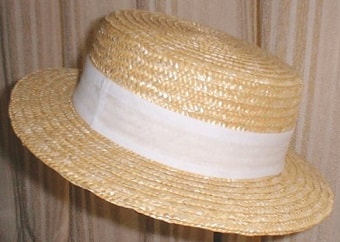
Conical hat — the distinctive hat worn primarily by farmers in Southeast Asia. The Asian conical hat is a simple style of conical hat originating in East, South, and Southeast Asia, particularly Bangladesh, Bhutan, China, Cambodia, India, Indonesia, Japan, Korea, Malaysia, Myanmar, Philippines, parts of Russian Manchuria and Vietnam. It is kept on the head by a cloth (often silk) chin strap.

Panama hat — a fine and expensive hat made in Ecuador. A Panama hat (toquilla straw hat) is a traditional brimmed straw hat of Ecuadorian origin. Traditionally, hats were made from the plaited leaves of the Carludovica palmata plant, known locally as the toquilla palm or jipijapa palm, although it is a palm-like plant rather than a true palm. Panama hats are light-colored, lightweight, and breathable, and often worn as accessories to summer-weight suits, such as those made of linen or silk.
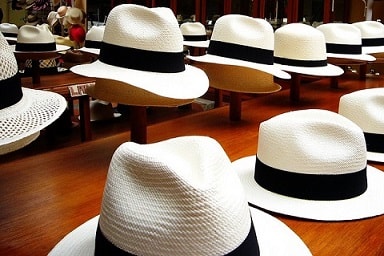
A petasos or petasus (Greek: πέτασος) is a sun hat of Thessalian origin worn by the ancient Greeks, often in combination with the chlamys cape. It was usually made of wool felt, leather or straw, with a broad, floppy brim. It was worn primarily by farmers and travellers, and was considered characteristic of rural people. As a winged hat, it became the symbol of Hermes, the Greek mythological messenger god (Roman equivalent Mercury).
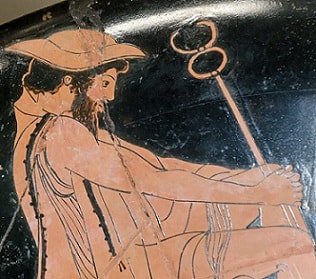
The pith helmet (also known as the safari helmet, sun helmet, topee, sola topee, salacot or topi[a]) is a lightweight cloth-covered helmet made of cork or pith, typically pith from the sola, Aeschynomene aspera, an Indian swamp plant, or A. paludosa, or a similar plant. Designed to shade the wearer's head and face from the sun, pith helmets were often worn by European travelers and explorers, in the varying climates found in Africa, southeast Asia, as well as the tropics, but have also been used in many other contexts.
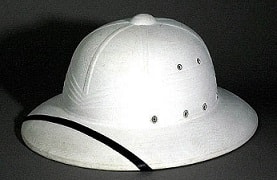
Baseball Hats also offer some sun protection. A baseball cap is a type of soft cap with a rounded crown and a stiff peak projecting in front. The front of the cap typically contains designs or logos of sports teams (namely baseball teams, or names of relevant companies, when used as a commercial marketing technique). The back of the cap may be "fitted" to the wearer's head size or it may have a plastic, Velcro, or elastic adjuster so that it can be quickly adjusted to fit different wearers. The baseball cap is a part of the traditional baseball uniform worn by players, with the brim pointing forward to shield the eyes from the sun. The cap is often seen in everyday casual wear. Learn about baseball hats at BaseballHats.org
A kasa is any of several sorts of traditional hats of Japan.[1] Some of the kasa hats are Amigasa, Jingasa, Sugegasa, Takuhatsugasa and Sandogasa. Amigasa is a traditional straw hat used in some Japanese folk dances. When preceded by a word specifying the type of hat, the word becomes gasa as in the jingasa (war hat). One kind of kasa (Takuhatsugasa) for Buddhist monks is made overlarge, in a bowl or mushroom shape and is made from woven rice straw. It does not come to a point like a rice farmer's hat, nor ride high on the head like a samurai's traveling hat. It is just a big hat covering the upper half to two thirds of the face.
A cowboy or cowgirl hat protects against sun as well. You can find nice cowgirl hats at Brit West.
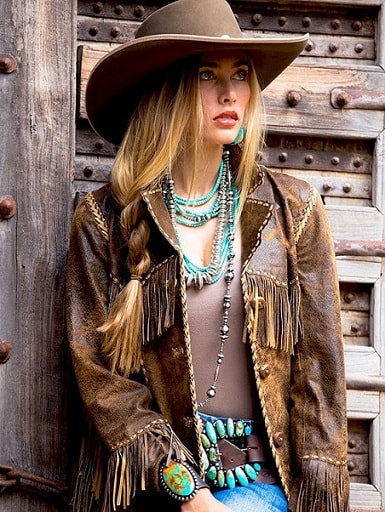
Global warming is the gradual heating of Earth's surface, oceans and atmosphere. Scientists have documented the rise in average temperatures worldwide since the late 1800s. Earth's average temperature has risen by 1.4 degrees Fahrenheit (0.8 degrees Celsius) over the past century, according to the Environmental Protection Agency (EPA). According to unqualified scientists here at Apparel Search, it has been determined that fashionistas and the general population should use more care in regard to sun protection. This includes the use of sun protective clothing such as sun hats.
The Sun is the star at the center of the Solar System and is by far the most important source of energy for life on Earth. Sunlight is a portion of the electromagnetic radiation given off by the Sun, in particular infrared, visible, and ultraviolet light. On Earth, sunlight is filtered through Earth's atmosphere, and is obvious as daylight when the Sun is above the horizon. When the direct solar radiation is not blocked by clouds, it is experienced as sunshine, a combination of bright light and radiant heat. When it is blocked by the clouds or reflects off other objects, it is experienced as diffused light. The ultraviolet radiation in sunlight has both positive and negative health effects, as it is both a principal source of vitamin D3 and a mutagen. In genetics, a mutagen is a physical or chemical agent that changes the genetic material, usually DNA, of an organism and thus increases the frequency of mutations above the natural background level. As many mutations can cause cancer, mutagens are therefore also likely to be carcinogens, although not always necessarily so. A carcinogen is any substance, radionuclide, or radiation that is an agent directly involved in causing cancer. This may be due to the ability to damage the genome or to the disruption of cellular metabolic processes. OK, that really does not sound very good for humans. More importantly, this is not sounding good for "fashionable humans" that want to look & feel their best.
How can we protect ourselves from the potentially harmful rays of the sun?
Sun protective clothing is clothing specifically designed for sun protection and is produced from a fabric rated for its level of ultraviolet (UV) protection. A novel weave structure and denier (related to thread count per inch) may produce sun protective properties. In addition, some textiles and fabrics employed in the use of sun protective clothing may be pre-treated with UV-inhibiting ingredients during manufacture to enhance their effectiveness.
In addition to special fabrics, sun protective clothing may also adhere to specific design parameters, including styling appropriate to full coverage of the skin most susceptible to UV damage. Long sleeves, full collars, and full-length trousers and skirts are common styles for clothing as a sun protective measure. Hats can also offer some protection by blocking bald spots on the head (of balding people), and by providing shade.
Links of possible interest:
Sun Protective Clothing Stores
Sun Protective Clothing Definition
Sun Protective Clothes Factories
What are good sun protective fabrics?
A number of fabrics and textiles in common use today need no further UV-blocking enhancement based on their inherent fiber structure, density of weave, and dye components, especially darker colors and indigo dyes. Good examples of these fabrics contain full percentages or blends of heavy-weight natural fibers like cotton, linen and hemp or light-weight synthetics such as polyester, nylon, spandex and polypropylene. Natural or synthetic indigo-dyed denim, twill weaves and canvas are also good examples. However, a significant disadvantage is the heat retention caused by heavier-weight and darker-colored fabrics. As sun protective clothing is usually meant to be worn during warm and humid weather, some UV-blocking textiles and clothing may be designed with ventilated weaves with moisture wicking properties to assist in cooling and breathability. Using antibacterial does not help with UV protection, but may be beneficial in other ways.
Factors that affect the level of sun protection provided by a fabric, in approximate order of importance, include weave, color, weight, stretch, and wetness. The less open or more dense the fabric (weave, weight, stretch), the better the protection. Getting a fabric wet reduces the protection as much as half, except for silk and viscose which can get more protective when wet. Polyester contains a benzene ring that absorbs UV light.
UV absorbers may be added at various points in the manufacturing process to enhance protection levels. In 2003, chemical company BASF embedded nanoparticles of titanium dioxide into a nylon fabric, which can be used for sun protective clothing that maintains its UV protection when wet.
Apparel Search has not done any testing or studies, but we do want to state that chemicals or other non-natural methods could have other potential negative health issues. Again, this is NOT based on our studies, it is just our opinion that fashionistas should try to go as natural as possible. This is one reason that sun hats are so important. Using a hat to create "shade" is good idea. Shade is a natural method of sun block.
Does fabric have UV protection ratings?
UPF (Ultraviolet Protection Factor) represents the ratio of sunburn-causing UV without and with the protection of the fabric, similar to SPF (Sun Protection Factor) ratings for sunscreen. While standard summer fabrics have UPF ~6, sun protective clothing typically has UPF ~30, which means that only 1 out of ~30 units of UV will pass through (~3%).
A relatively new rating designation for sun protective textiles and clothing is UPF (Ultraviolet Protection Factor), which represents the ratio of sunburn-causing UV measured without and with the protection of the fabric. For example, a fabric rated UPF 30 means that, if 30 units of UV fall on the fabric, only 1 unit will pass through to the skin. A UPF 30 fabric that blocks 29 out of 30 units of UV is therefore blocking 96.7%. Unlike SPF (Sun Protection Factor) measurements that traditionally use human sunburn testing, UPF is measured using a laboratory instrument (spectrophotometer or spectroradiometer) and an artificial light source, and then applying a sunburn weighting curve (erythemal action spectrum) across the relevant UV wavelengths. Theoretically, human SPF testing and instrument UPF testing both generate comparable measurements of a product's ability to protect against sunburn.
How is UPF tested?
Developed in 1998 by Committee RA106, the testing standard for sun protective fabrics in the United States is the American Association of Textile Chemists and Colorists (AATCC) Test Method 183.[7] This method is based on the original guidelines established in Australia in 1994. AATCC 183 should be used in conjunction with other related standards including ASTM D 6544[8] and ASTM D 6603.[9] ASTM D 6544 specifies simulating the life cycle of a fabric so that a UPF test can be done near the end of the fabric's life, when it typically provides the least UV protection. ASTM D 6603 is a consumer format recommended for visible hangtag and care labeling of sun protective clothing and textiles. A manufacturer may publish a test result to a maximum of UPF 50+. Sun protective clothing and textile/fabric manufacturers are currently a self-regulating industry in North America, prescribed by the AATCC and ASTM methods of testing.
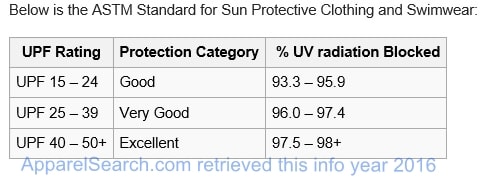
Historical hat company providing sun protection hats:
International Hat Company, formerly named the International Harvester Hat Company, was a St. Louis, Missouri based manufacturer of commercial hats and military helmets. The company is best remembered for its mass production of tropical shaped, military fiber helmets for soldiers of the United States Army, Marines, and Navy during and after World War II. However, the American owned company was also a major producer of harvester straw hats, fiber sun hats, enameled dress hats, and baseball caps throughout most of the 20th century.
Learn more about hats.
You should alway pack a hat to bring with you if you are planning on being out in the sun. Learn about different types of packable hats.
When the goal is to keep the sun out of your eyes & off your face, you may want to learn about visors.
It may be a good idea to visit our beach hats page as well just so you know another term that is directly relevant.
If you are concern about the rays of the sun, you may want to also wear a swim shirt & sunglasses at the beach or out in the sun in general.
Learn about spring fashion & summer fashion.
Fashion Products Fashion Products S-Z Fashion Products S
Return to the Influence
Fashion home page.
Copyright 1999-2023 Apparel Search Company. All Rights Reserved.